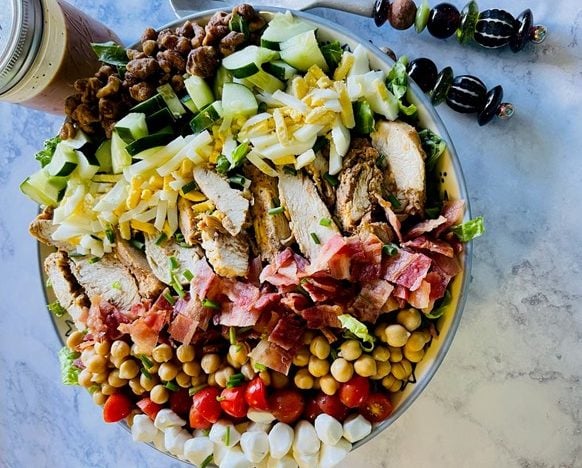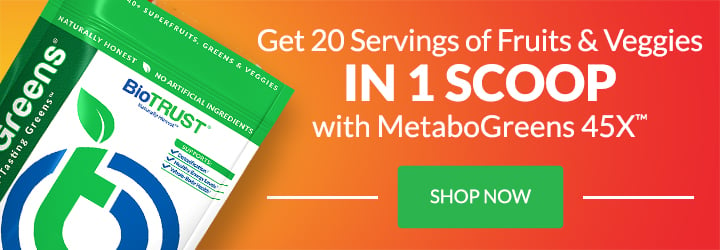High-Protein Chopped Summer Salad Recipe

Much like Elaine on Seinfeld, I am a big, actually HUGE, fan of the “big salad.” I could eat salads for every meal, and honestly, it wouldn’t be the worst idea to optimize my health and wellness.
Once reserved for rabbits and folks who were doing extreme dieting, the salad has always gotten (for the most part) a bad rap. But if you have noticed, folks everywhere are getting pretty darn creative when it comes to dressing up the leafy greens.
I like to mix up the flavor combinations and use fresh fruits and veggies that are in season, along with fresh herbs and spices, and always a homemade dressing.
To begin, I generally opt for darker leafy greens, and I like to mix things up. Spinach, arugula, Swiss chard, kale, mustard greens…there is no limit to what types of greens you can layer on the bottom of your salad bowl. The more the merrier! I start with a good two cups.
Next up, I like to select different textures and flavors to really cover all my macro and micronutrient bases, so the big salad can be a well-balanced meal. My creation today consisted of the following:
1. Grilled chicken. You really can’t go wrong when it comes to selecting a protein. I prefer a grilled option over breaded or fried for obvious reasons and use about a half of a breast. Because it’s high in protein, chicken may help with weight management and reduce the risk of heart disease. Chicken also provides tryptophan, an amino acid linked with higher levels of serotonin (the “feel-good” hormone in our brains).
2. Mozzarella. In my opinion, any cheese is a good addition to a salad, as it’s chockful of protein, but when you have an abundance of flavorful ingredients, I like to go with something on the mild side like mozzarella and use just a single one-ounce serving. As a bonus, cheese is rich in calcium, and a 30-gram portion contains 18% of your daily calcium needs. Mozzarella also contains phosphorus, a mineral that allows the body to use calcium.
3. Chickpeas. Otherwise known as garbanzo beans, these tasty little golden nuggets are a fantastic source of fiber as well as nutrients like folate, manganese, iron, magnesium, and phosphorus. They’re also a good source of protein. Fiber improves digestive health and helps control weight. Finally, according to research, it may help protect against colorectal cancer and other diseases. I add around a quarter cup.
4. Bacon. With the rise in popularity of the ketogenic diet, bacon has been touted as a superfood among the diet’s followers. But even if you aren’t following the keto trend, bacon can still be included in your healthy diet.
Almost half the fat content is monounsaturated, which is known to help lower cholesterol levels. And its monounsaturated content comes from oleic acid, the same “good” fat found in olive oil. Portion size is really what it’s about when it comes to bacon. I use just one slice, cooked and diced.
5. Chives. Not only do chives impart flavor to many recipes, chives also offer some health benefits. As reported from the Illinois State University horticulture center, chives were originally brought to America by colonists to use as medicine.
These vegetables provide vitamins and minerals, such as vitamin C and calcium, as well as other antioxidants that may help prevent disease.
Add as much diced chives as you’d like to your big salad as they add a lot of flavor with very few calories.
6. Walnuts. Walnuts have a wealth of the good kind of fats—polyunsaturated fats, which are better for you than saturated fats, along with omega-3 fatty acids.
According to research, eating walnuts may help lower overall cholesterol levels and LDL (“bad”) cholesterol in particular. This is important as cholesterol can form plaque inside arteries, increasing the risk of heart disease, and eating walnuts can help keep artery walls healthy.
Because walnuts are also rich in calories, watch your portion size. I typically add about one quarter ounce.
7. Tomatoes. Tomatoes are the most well-known dietary source of lycopene, an antioxidant linked to many health benefits, including reduced risk of heart disease and cancer. Tomatoes also provide vitamin C, potassium, folate, and vitamin K.
8. Hard-boiled eggs. Another nutrient-rich food, eggs provide selenium, vitamin D, B6, B12, and minerals such as copper, iron, and zinc. While egg yolks are sometimes avoided because they contain more calories and fat than egg whites, this is a mistake. The whole egg provides fat-soluble vitamins A, D, E, and K as well as lecithin, the compound that enables emulsification in recipes such as hollandaise or mayonnaise. I’ll typically add half of a hard-boiled egg to the salad.
9. Cucumbers. Antioxidants such as beta-carotene in cucumbers can help fight free radicals in your body. Free radicals are unpaired electrons that damage cells and can lead to disease.
Fun fact: Cucumbers may also have health benefits outside your body. Placing them on your skin may help ease the discomfort of sunburn, reduce swelling, and help soothe damaged skin.
I’ll dice up around half a cucumber for my big salad.
Finally, I always top my big salad with a delicious, homemade dressing. Here’s one of my go-to recipes that works well with all of the above ingredients:

Ingredients
Balsamic Vinaigrette Dressing
- ¼ cup balsamic vinegar
- ¼ cup extra virgin olive oil
- 3 tbsp honey
- 2 tsp Dijon mustard
- ½ tsp thyme
- 1 clove garlic minced
- salt and pepper to taste
Instructions
Balsamic Vinaigrette Dressing
- Place all ingredients into a mason jar (or other tightly sealed container), and shake vigorously.
- Use one to two tablespoons drizzled over your BIG salad and enjoy!




 7 Signs Your Body is Seriously Low on Collagen (not just wrinkles)
7 Signs Your Body is Seriously Low on Collagen (not just wrinkles) Health Expert: "Turmeric Doesn't Work (unless...)"
Health Expert: "Turmeric Doesn't Work (unless...)" 3 Warning Signs Your Probiotic Supplement is a Total Waste
3 Warning Signs Your Probiotic Supplement is a Total Waste

